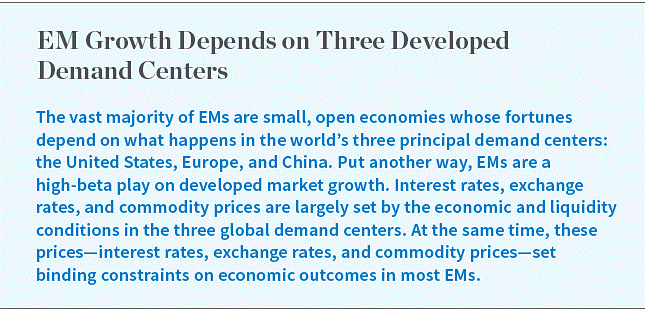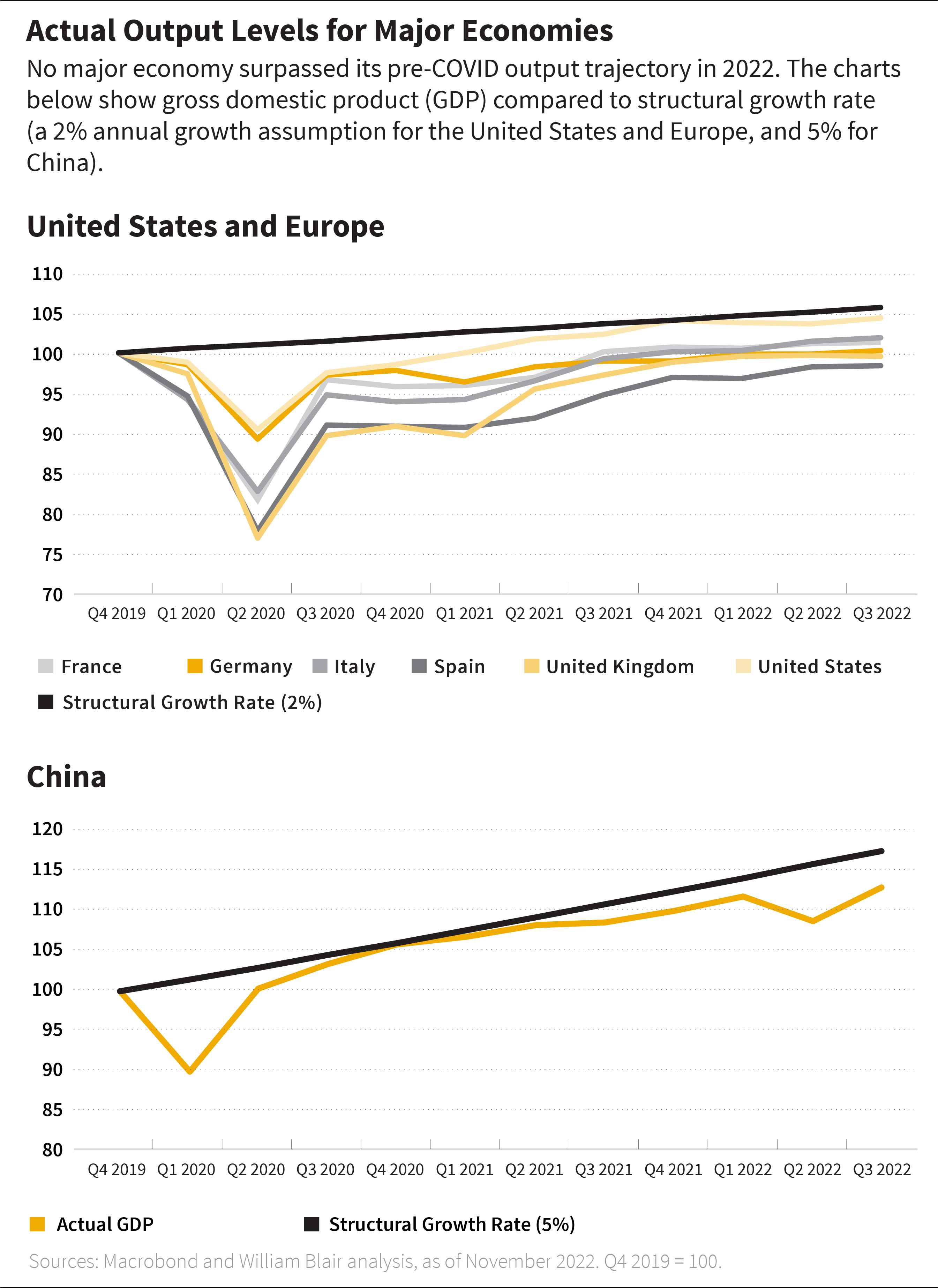January 3, 2023 | Global Equity
Outlook 2023: Better Than Feared

As we look out to 2023, the U.S. Federal Reserve (Fed) has reached its “neutral” monetary policy stance, and the European Central Bank (ECB) is not far behind. Europe has moved fast to secure fossil fuel supply away from Russia, even at higher—but stable—prices. U.S. consumer price inflation is moderating. Asynchronous reopening, with China’s consumers set to rejoin the post-COVID economy, is likely to mean more inflation volatility next year.
Even so, if we can avoid geopolitical pressures escalating meaningfully from current levels (which are already uncomfortably high), can the world’s biggest demand centers pivot toward a multiyear cycle of modest but sustainable growth?
If so, equities may not be a bad place to be in 2023.
Slowflation—economic slowdown combined with rapidly rising inflation fueled by energy supply disruptions—proved a tough backdrop for financial markets in 2022. In the past two decades, only 2008 recorded worse returns for equities, while fixed-income investors have not had to contend with the likes of the year’s declines even in the depths of the Global Financial Crisis (GFC). On an absolute basis, both equities and fixed income were down about 14% to 18%.
The post-COVID economic transition back to something “more normal” proved volatile and is complicated further by rising geopolitical conflicts. None of the major economic powers have surpassed their pre-COVID output trajectories. The U.S. economy is the closest: by the end of the third quarter of 2022, its output was about 1.5% lower than it might have been in the absence of the pandemic. Euro area and Japanese output is more than 3.5% lower. And in larger EM economies, such as China, Brazil, and Indonesia, output ranges from about 5% to 7% lower.
Latest expectations, as embedded in consensus estimates, suggest that economic observers do not expect major economies to regain pre-COVID levels of output next year.


Energy Prices Should Ease
Open warfare between Russia and Ukraine amplified tensions between the world’s largest consumers of fossil fuel energy and its producers. Although the world has plenty of oil and gas, natural gas spot prices in Europe spiked to about seven times higher in 2022 compared to just one year prior. No economy can adjust to a cost shock of this magnitude in the space of a few quarters. Indeed, purchasing managers indices were already suggesting in the autumn of 2022 that the European economy is likely to enter a recession.
Today’s high prices may well lead to tomorrow’s low prices, and tomorrow may arrive sooner than many feared.
Although the outlook for fossil fuel energy supply in Europe remains unusually volatile, the risks are balanced. The Organization of the Petroleum Exporting Countries (OPEC) sought to limit crude supply by cutting daily production by 2 million barrels, just as Europe and the United States are implementing the next round of sanctions on Russian barrels (in part by barring Western firms from insuring Russian cargo).
Simultaneously, Germany has all but replaced importing capacity equivalent to its gas supply from the Nord Stream I pipeline. The government chartered five so-called floating storage and regasification units (FSRUs), which will be able to process 25 billion cubic meters of gas per year, roughly equivalent to half the capacity of the Nord Stream I pipeline. Meanwhile, the country’s first liquified natural gas (LNG) import terminal, in the port of Wilhelmshaven, is expected to be completed in early 2023—commissioned and built in less than a year.
A glut of LNG-carrying vessels destined for Europe, together with rapidly increasing capacity to process this supply, suggests that the meteoric rise of LNG prices and its dramatic drag on European inflation may be a story left in 2022. What is more, within a few years, Qatar and the United States should expand their respective LNG export capacity, and Europe should build enough proper import terminals. Today’s high prices may well lead to tomorrow’s low prices, and tomorrow may arrive sooner than many feared.
But Central Banks Can’t Wait
Yet the world’s leading central banks have signaled that they will not wait.
Perhaps one of the biggest surprises in 2022 was the speed with which the Fed moved its main policy rate toward a neutral stance. Assuming annual domestic inflation returns to a 2% to 3% range by the end of 2023, a neutral policy rate—where real rate is around 1.5%—is somewhere in the neighborhood of 3.5% to 4.5%. The federal funds rate—the Fed’s main policy instrument—currently stands at 4.50%. Further rate increases tilt the U.S. monetary-policy stance toward restrictive.
Asynchronous reopening is set to bedevil the global economy for at least another year.
When the Fed intends to stop lifting its benchmark rate is a matter of not only domestic economic concern. Rapidly rising interest rates impact global liquidity conditions. We have already seen macroeconomic stress in Sri Lanka, a near credit event of sorts in the United Kingdom, and a blowup in the cryptocurrency markets.
So far, these stresses have not spilled into broader markets, but interest-rate increases impact financial conditions non-linearly. Debt payments of all sorts, and especially housing payments the world over, are linked directly to prevailing interest rates; when these rise rapidly, the possibility of financial and economic stress rises, too.
2023 Growth Depends on Inflation
Asynchronous reopening is set to bedevil the global economy for at least another year. We believe economic growth in the United States and Europe will depend largely on how quickly inflation abates.
This, in turn, depends on when and how China reopens its economy. A full or significant reopening in China is likely to impact tourism flows in Asia and further afield, especially in Europe and North America. This should buoy local domestic demand and may fuel services-related inflation in the affected jurisdictions. It should also support current accounts and local currencies from Thailand and Japan all the way to Europe.
China’s reopening is likely to make inflation readings in the United States and Europe more volatile and thereby complicate the Fed’s job of cooling domestic demand. In the absence of Chinese consumers, there are mounting reasons to believe that annual inflation of 3% toward the end of next year is attainable. Since the second half of 2022, housing and rental prices, continued improvement in supply chains, and domestic wage gains all point to accelerating moderation in annual inflation.
Let’s start with housing. The price of shelter accounts for nearly 40% of the Consumer Price Index (CPI); it is thus the single biggest—and stickiest—component of the U.S. basket of prices used to calculate national inflation. As 30-year fixed-rate mortgage rates passed 5% and then 6%, housing activity decelerated precipitously: sales of new builds are at the 2017-2019 average, while sales of existing homes are at decade lows and still falling.
Where transactions lead, prices follow: annual housing price inflation peaked in May 2022 and has been falling consistently since then. Private-sector measures of rentals point to outright price declines in the monthly data. Shelter inflation is notoriously difficult to convert into monthly CPI estimates, and we believe it will remain a drag on overall inflation for months to come, but broad housing market activity during much of 2022 suggests that we will see well-behaved shelter prices before the end of 2023.
Broad housing market activity during much of 2022 suggests that we will see well-behaved shelter prices before the end of 2023.
Goods prices reversed two decades of outright declines and grew strongly in the pandemic years. Supply-chain disruption proved difficult to remedy quickly, but as we enter 2023, spot price of a typical 40-foot shipping container is down some 80% from peak, purchasing manager surveys point to input price normalization, and suppliers’ delivery times are within reach of 2018-2019 averages. Annual goods price inflation peaked last February and has been declining steadily ever since.
Lower-value-add, high-touch services do not see much in the way of productivity gains. It is difficult—and maybe even undesirable—to increase the speed of a haircut or improve the efficiency of waitstaff beyond a certain point. For this reason, the Fed worries about wage inflation in services feeding directly into consumer price inflation. Yet, in the second half of 2022, services wage gains have decelerated from four-decade highs.
So, if the Fed reaches its neutral monetary policy stance and the ECB is not far behind; if fossil fuel supply away from Russia is secured, even at higher (but stable) prices; if consumer price inflation is moderating fast and the Fed does not overtighten into a major credit event somewhere; and crucially, if geopolitical pressures do not escalate meaningfully from their current uncomfortably high levels—then the world’s biggest demand centers may be able to pivot toward modest growth.
If so, risk assets may not be a bad place to be in 2023.
Olga Bitel, partner, is a global strategist on William Blair’s Global Equity team.
Emerging Markets 2023 Outlook Series
Part 1 | Outlook 2023: Better Than Feared
Part 2 | Emerging Markets Equities: Positioned for a Rebound?
Part 3 | Emerging Markets Debt: Clearer Skies Ahead?
Part 4 | China: Reopening Should Drive Growth
